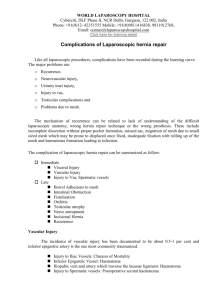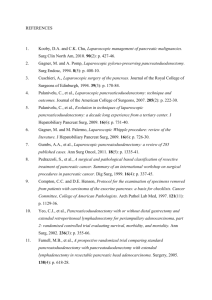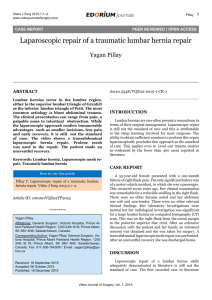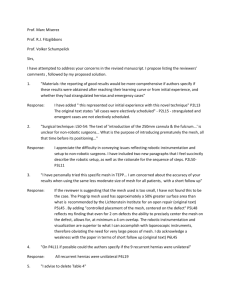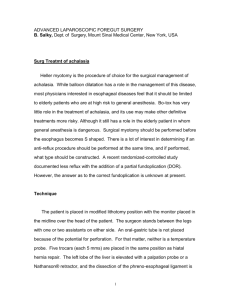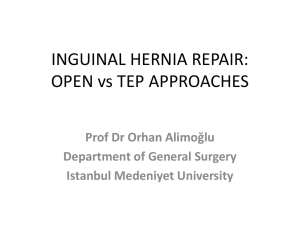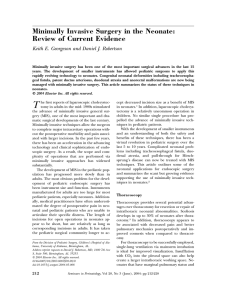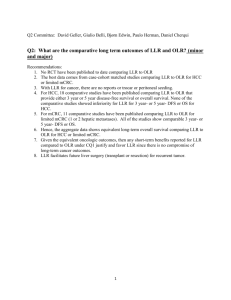lap ventral hernia rating form
advertisement
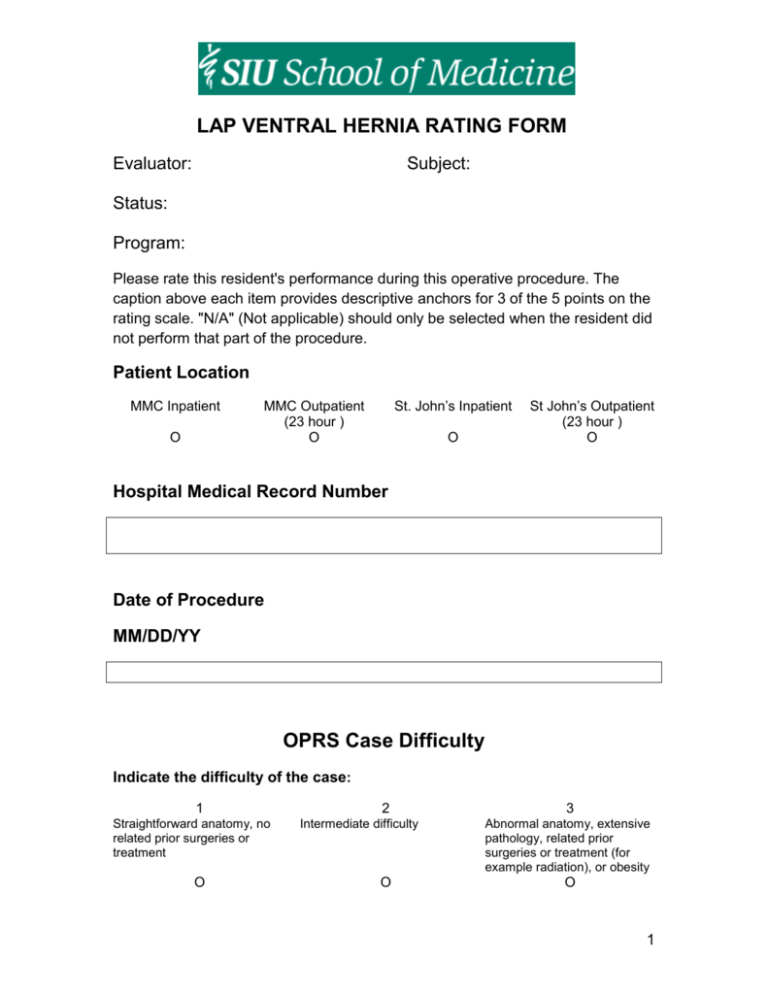
LAP VENTRAL HERNIA RATING FORM Evaluator: Subject: Status: Program: Please rate this resident's performance during this operative procedure. The caption above each item provides descriptive anchors for 3 of the 5 points on the rating scale. "N/A" (Not applicable) should only be selected when the resident did not perform that part of the procedure. Patient Location MMC Inpatient O St. John’s Inpatient MMC Outpatient (23 hour ) O O St John’s Outpatient (23 hour ) O Hospital Medical Record Number Date of Procedure MM/DD/YY OPRS Case Difficulty Indicate the difficulty of the case: 1 Straightforward anatomy, no related prior surgeries or treatment O 2 Intermediate difficulty O 3 Abnormal anatomy, extensive pathology, related prior surgeries or treatment (for example radiation), or obesity O 1 Degree of Prompting or Direction 1 2 Substantial direction by attending. Resident performs all steps but the attending provides constant direction to the resident and surgical team. 3 Some direction by attending. Resident performs all steps but the attending provides occasional direction to the resident and /or to the surgical team. O Minimal direction by attending. Resident performs all steps and directs the surgical team independently with minimum or no direction from the attending, to either the resident or to the surgical team. O O Procedure Specific Criteria Incision / Port Placement 5 Excellent 4 Very Good Safe, efficient and optimal positioning of ports for procedure, & anatomy O O 3 Good 2 Fair Functional but awkward port positioning, generally safe technique, some difficulty inserting ports. O 1 Poor NA Poor choice of port position, unsafe technique insertion /removal. O O O Exposure - Pneumoperitoneum 5 Excellent Efficient establishment & maintenance of appropriate pneumoperitoneum, camera angle and retraction 4 Very Good 3 Good Adequate establishment and maintenance of pneumoperitoneum, camera angle and retraction but with occasional loss of 2 Fair 1 Poor NA Inadequate pneumoperitoneum, camera angle and retraction with frequent loss of exposure 2 O O exposure. O O O O Exposure – Identification 5 Excellent 4 Very Good 2 Fair 1 Poor NA O O Poor dissection technique with inadequate exposure of fascial edge and sac. Complete reliance on faculty for identification of sac & reduction of sac and contents. O O 4 Very Good 3 Good 2 Fair 1 Poor NA O Satisfactory (required some direction) sizing of mesh, and positioning of sutures O O O O 3 Good 2 Fair 1 Poor NA Precise and efficient dissection of adhesions to expose entire fascial edge, sac and contents. Efficient reduction of sac O 3 Good Satisfactory dissection & mobilization with occasional inefficient dissection. Incomplete exposure of fascial edge. Satisfactory reduction of sac. O Preparation of mesh 5 Excellent Excellent (independent) sizing of mesh, & positioning of sutures.. O Inadequate or inappropriate sizing of mesh with complete reliance on faculty instruction. Placement of mesh 5 Excellent Excellent positioning & placement of sutures without tension or redundancy. 4 Very Good Satisfactory (required some direction), placement without tension or Inadequate orientation of mesh, & suturing with complete reliance on faculty 3 O O redundancy. O O instruction. O O General Criteria Instrument Handling 5 Excellent 4 Very Good Fluid movements with instruments consistently using appropriate force, keeping tips in view, and placing clips placed securely. 3 Good 2 Fair Competent use of instruments, occasionally appeared awkward, or did not visualize instrument tips O O 1 Poor NA Tentative or awkward movements often did not visualize tips of instrument, or clips poorly placed. O O O O 3 Good 2 Fair 1 Poor NA Respect for Tissue 5 Excellent 4 Very Good Consistently handled tissue carefully (appropriately), minimal tissue damage Frequent unnecessary tissue force or damage by inappropriate instrument use. Careful tissue handling, occasional inadvertent damage O O O O O O 4 Very Good 3 Good 2 Fair 1 Poor NA Time and Motion 5 Excellent Clear economy of motion, and maximum efficiency O Efficient time & motion, some unnecessary moves O O Many unnecessary moves O O O 4 Operation Flow 5 Excellent 4 Very Good Obviously planned course of operation and anticipation of next steps. 3 Good 2 Fair 1 Poor □ Some forward planning, reasonable procedure progression NA Frequent lack of forward progression; frequently stopped operating and seemed unsure of next move . O O O O O O Overall Performance 5 Excellent 4 Very Good 3 Good 2 Fair 1 Poor NA O O O O O O Please indicate the weaknesses in this resident’s performance: Please indicate the strengths in this resident’s performance: References 5 1. Bingener J, Buck L, Richards M et al. Long term outcomes in laparoscopic vs. open ventral hernia repair. Arch Surg 2007; 142: 562 - 567. 2. Birch D. Characterizing laparoscopic incisional hernia repair. Can J Surg. 2007;50(3):195 - 200 3. Novitsky Y, Cobb W, Kercher KW et al. Laparoscopic ventral hernia repair in obese patients. Arch Surg 2006; 141:57 - 61. 4. Perrone J, Soper NJ, Eagon C et al. Perioperative outcomes and complications of laparoscopic ventral hernia repair. Surgery 2005; 138:708 - 16. 5. Mudge, M, Hughes, LE. Incisional hernia: a 10 year prospective study of incidence and attitudes. Br J Surg 1985; 72:70. 6. Hodgson, NC, Malthaner, RA, Ostbye, T. The search for an ideal method of abdominal fascial closure: a meta-analysis. Ann Surg 2000; 231:436. 7. Flum, DR, Horvath, K, Koepsell, T. Have outcomes of incisional hernia repair improved with time? A population-based analysis. Ann Surg 2003; 237:129. 8. DeMaria, EJ, Moss, JM, Sugerman, HJ. Laparoscopic intraperitoneal polytetrafluoroethylene (PTFE) prosthetic patch repair of ventral hernia. Prospective comparison to open prefascial polypropylene mesh repair. Surg Endosc 2000; 14:326. 9. Cobb, WS, Kercher, KW, Heniford, BT. Laparoscopic repair of incisional hernias. Surg Clin North Am 2005; 85:91. 10. Berger, D, Bientzle, M, Muller, A. Postoperative complications after laparoscopic incisional hernia repair. Incidence and treatment. Surg Endosc 2002; 16:1720. 11. Heniford, BT, Park, A, Ramshaw, BJ, Voeller, G. Laparoscopic repair of ventral hernias: nine years' experience with 850 consecutive hernias. Ann Surg 2003; 238:391. 12. Ujiki, MB, Weinberger, J, Varghese, TK, et al. One hundred consecutive laparoscopic ventral hernia repairs. Am J Surg 2004; 188:593. 13. Cassar, K, Munro, A. Surgical treatment of incisional hernia. Br J Surg 2002; 89:534. 14. Carbajo, MA, Martin, del Olmo JC, Blanco, JI, et al. Laparoscopic treatment vs. open surgery in the solution of major incisional and abdominal wall hernias with mesh. Surg Endosc 1999; 13:250. 6


